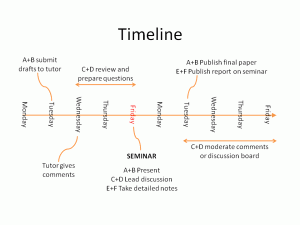Sometimes we hear that people think the E-learning Team do nothing but Blackboard. This sometimes feels like the case to us too, but often that’s because we have a lot of people asking for help with Blackboard. Actually, often people aren’t really asking us about Blackboard, and as consultants you will quite often find that our initial response is to remove Blackboard from the equation, probing more closely into what you are all actually wanting to achieve with your students and making sure that what you originally asked us for is the most appropriate and efficient way for you to be achieving those desired outcomes. There will no doubt be plenty of posts coming up on Blackboard as we add more functionality in the summer to the Bb9 platform – for example easy search and inclusion of external resources like images and videos for a start – so I want to write a few posts first which focus on some other, less Bb-specific things, but which can link through/to Bb.
This first post then, I want, as the E-learning Team usually do, to refer us back to the students, their needs and desires, and suggest it’s worth people’s time to read through this research project by a student on what students want. On Teaching and Technology underlines some of our priorities about their engagement with [our] technology enhanced learning.  One really interesting finding I flagged up is that students don’t want to do follow up but will take part in preparation activities. We have a model that we use in workshops on group work that is part of a ‘seminar extension model’ I wrote some years ago, designed to maximise student involvement in a process where it’s only too easy to only put the hours in if it’s your presentation week. This model includes providing wiki or discussion board activities to support continuing the conversation after a session, but the key feature is ‘continuing’, which implies that something has gone before. In fact the seminar model is predicated on having the students engage more in advance of the f2f session, and though I would hope this would lead to the kind of lively debate that might run on beyond the class, which is always an extra added value beyond the actual session.
One really interesting finding I flagged up is that students don’t want to do follow up but will take part in preparation activities. We have a model that we use in workshops on group work that is part of a ‘seminar extension model’ I wrote some years ago, designed to maximise student involvement in a process where it’s only too easy to only put the hours in if it’s your presentation week. This model includes providing wiki or discussion board activities to support continuing the conversation after a session, but the key feature is ‘continuing’, which implies that something has gone before. In fact the seminar model is predicated on having the students engage more in advance of the f2f session, and though I would hope this would lead to the kind of lively debate that might run on beyond the class, which is always an extra added value beyond the actual session.
Other findings correspond to other things that in the e-learning team we are often trying to encourage – more visual and audio engagement, and trying to create a sense of community. Also, especially with our students leading busy lives, the real bonus of easily accessible readings. It’s a great post – we couldn’t have written it better ourselves. In a world where we have so many competing demands on our time that pulling the file off the shelf and blowing off the dust as we run to a lecture may not be too far from a dangerous truth, but where we would really like to invest a bit of time in seeing where technology-enhanced learning can promote pro-active pedagogy, it’s great to have the students giving us some starting ideas…
